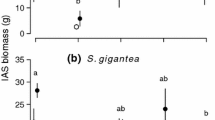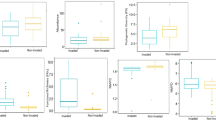Abstract
In order to understand invasions, it is important to know how alien species exploit opportunities in unfamiliar ecosystems. For example, are aliens concentrated in niches under-exploited by native communities, or widely distributed across the ecological spectrum? To explore this question, we compared the niches occupied by 394 naturalized alien plants with a representative sample from the native flora of Mediterranean islands. When niche structure was described by a functional group categorization, the distribution of native and alien species was remarkably similar, although “succulent shrubs” and “trees with specialized animal pollination mechanisms” were under-represented in the native species pool. When niche structure was described by Grime’s CSR strategy, the positioning of aliens and natives differed more strongly. Stress-tolerance was much rarer amongst the aliens, and a competitive strategy was more prevalent at the habitat level. This pattern is similar to previous findings in temperate Europe, although in those regions it closely reflects patterns of native diversity. Stressed environments are much more dominant in the Mediterranean. We discuss a number of factors which may contribute to this difference, e.g., competitive and ruderal niches are often associated with anthropogenic habitats, and their high invasibility may be due partly to introduction patterns rather than to a greater efficiency of aliens at exploiting them. Thus far, the reasons for invasion success amongst introduced species have proved difficult to unravel. Despite some differences, our evidence suggests that alien species naturalize across a wide range of niches. Given that their ecologies therefore vary greatly, one may ask why such species should be expected to share predictable traits at all?




Similar content being viewed by others
References
Badano EI, Pugnaire FI (2004) Invasion of Agave species (Agavaceae) in south-eastern Spain: invader demographic parameters and impacts on native species. Divers Distrib 10:493–500
Beckett E (1993) Illustrated flora of Mallorca. Ed Moll, Mallorca
Bell CE, Wilen CA, Stanton AE (2003) Invasive plants of horticultural origin. Hortscience 38:14–16
Blondel J, Aronson J (1999) Biology and Wildlife of the Mediterranean Region. Oxford University Press, Oxford, UK
Burke MJ, Grime JP (1996) An experimental study of plant community invasibility. Ecology 77:776–790
Callaway RM, Aschehoug ET (2000) Invasive plants versus their new and old neighbors: a mechanism for exotic invasion. Science 290:521–523
Chittka I, Schürkens S (2001) Successful invasion of a floral market. Nature 411:653
Chytrý M, Pyšek P, Tichý L, Knollová I, Danihelka J (2005) Invasions by alien plants in the Czech Republic: a quantitative assessment across habitats. Preslia 77:339–354
Cizek O, Bakesova A, Kuras T, Benes J, Konvicka M (2003) Vacant niche in alpine habitat: the case of an introduced population of the butterfly Erebia epiphron in the Krkonose Mountains. Acta Oecol 24:15–23
Daehler CC, Strong DR (1993) Prediction and biological invasions. Trends Ecol Evol 8:380–380
Deutschewitz K, Lausch A, Kühn I, Klotz S (2003) Native and alien plant species richness in relation to spatial heterogeneity on a regional scale in Germany. Glob Ecol Biogeogr 12:299–311
Dietz H, Ullmann I (1997) Phenological shifts of the alien colonizer Bunias orientalis: image-based analysis of temporal niche separation. J Veg Sci 8:839–846
Foxcroft LC, Rouget M, Richardson DM, MacFayden S (2004) Reconstructing 50 years of Opuntia stricta invasion in the Kruger National Park, South Africa: environmental determinants and propagule pressure. Divers Distrib 10:427–437
Goodwin BJ, McAllister AJ, Fahrig L (1999) Predicting invasiveness of plant species based on biological information. Conserv Biol 13:422–426
Grime JP (1974) Vegetation classification by reference to strategies. Nature 250:26–31
Grime JP (2007) Plant strategy theories: a comment on Craine (2005). J Ecol 95:227–230
Grime JP, Hodgson JG, Hunt R (1988) Comparative plant ecology. Unwin Hyman ltd., London, UK
Groves RH (1986) Invasion of Mediterranean ecosystems by weeds. In: Dell B, Hopkins AJM,Lamont BB (eds) Resilience in Mediterranean-type ecosystems. Dr. W. Junk Publishers, Dordrecht, pp 129–145
Guillerm JL (1991) Weed invasion in agricultural areas. In: Groves RH,di Castri F (eds) Biogeography of Mediterranean invasions. Cambridge University Press, Cambridge, UK, pp 379–392
Gurvich DE, Tecco PA, Diaz S (2005) Plant invasions in undisturbed ecosystems: the triggering attribute approach. J Veg Sci 16:723–728
Haslam SM, Sell PD, Wolseley PA (1977) A flora of the Maltese islands. Malta University Press, Msida
Hobbs RJ, Humphries SE (1995) An integrated approach to the ecology and management of plant invasions. Conserv Biol 9:761–770
Holmgren M, Avilés R, Sierralta L, Segura AM, Fuentes ER (2000) Why have European herbs so successfully invaded the Chilean matorral? Effects of herbivory, soil nutrients, and fire. J Arid Environ 44:197–211
Hulme PE (2003) Biological invasions: winning the science battles but losing the conservation war? Oryx 37:178–193
Keane RM, Crawley MJ (2002) Exotic plant invasions and the enemy release hypothesis. Trends Ecol Evol 17:164–169
Kühn I, Klotz S (2006) Urbanization and homogenization—comparing the floras of urban and rural areas in Germany. Biol Conserv 127:292–300
Lambdon PW, Hulme PE (2006a) How strongly do interactions with closely-related native species influence plant invasions? Darwin’s naturalization hypothesis assessed on Mediterranean islands. J Biogeogr 33:1116–1125
Lambdon PW, Hulme PE (2006b) Predicting the invasion success of Mediterranean alien plants from their introduction characteristics. Ecography 29:853–865
Larson DL, Anderson PJ, Newton W (2001) Alien plant invasion in mixed-grass prairie: effects of vegetation type and anthropogenic disturbance. Ecol Appl 11:128–141
Levine JM, D’Antonio CM (1999) Elton revisited: a review of evidence linking biodiversity and invasibility. Oikos 87:15–26
Lewalle J, Montford N (1997) Fleurs sauvages du Maroc. Verlagsgesellschaft, Rossdorf, Germany
Lloret F, Médail F, Brundu G, Camarda I, Moragues E, Rita J, Lambdon PW, Hulme PE (2005) Species attributes and invasion success by alien plants on Mediterranean islands. J Ecol 93:512–520
Lonsdale WM (1999) Global patterns of plant invasions and the concept of invasibility. Ecology 80:1522–1536
Mack RN, Erneberg M (2002) The United States naturalized flora: largely the product of deliberate introductions. Ann Mo Bot Gard 89:176–189
Maskell LC, Firbank LG, Thompson K, Bullock JM, Smart SM (2006) Interactions between non-native plant species and the floristic composition of common habitats. J Ecol 94:1052–1060
McKinney ML (2006) Urbanization as a major cause of biotic homogenization. Biol Conserv 127:247–260
Pino J, Font X, Carbó J, Jové M, Pallarès L (2005) Large-scale correlates of alien plant invasion in Catalonia (NE of Spain). Biol Conserv 122:339–350
Preston CD, Pearman DA, Hall AR (2004) Archeophytes in Britain. Bot J Linn Soc 145:257–294
Prieur-Richard AH, Lavorel S (2000) Do more diverse plant communities have greater resistance to invasions? Revue D Ecologie-La Terre Et La Vie 37–51
Pyšek P, Hulme PE (2005) Spatio-temporal dynamics of plant invasions: linking patterns to process. Écoscience 12:302–315
Pyšek P, Jarošík V, Chytrý M, Kropác Z, Tichý L, Wild J (2005) Alien plants in temperate weed communities: prehistoric and recent invaders occupy different habitats. Ecology 86:772–785
Pyšek P, Prach K, Smilauer P (1995) Relating invasion success to plant traits: an analysis of the Czech alien flora. In: Pyšek P et al (eds) Plant invasions—general aspects and special problems. SPB Academic Publishing, Amsterdam, pp 39–60
Pyšek P, Richardson DM (2007) Traits associated with invasiveness in alien plants: where do we stand?. In: Nentwig W (ed) Biological invasions. Springer-Verlag, Berlin/Heidelberg, Germany, pp 97–125
Rackham O, Moody J (1996) The making of the Cretan landscape. Manchester University Press, Manchester, UK
Rejmánek M (2000) Invasive plants: approaches and predictions. Austral Ecol 25:497–506
Richardson DM, Pyšek P, Rejmánek M, Barbour MG, Panetta FD, West CJ (2000) Naturalization and invasion of alien plants. Concepts and definitions. Divers Distrib 6:93–107
Richardson DM, Rejmánek M (2004) Conifers as invasive aliens: a global survey and predictive framework. Divers Distrib 10:321–331
Rodgers JC, Parker KC (2003) Distribution of alien plant species in relation to human disturbance on the Georgia Sea Islands. Divers Distrib 9:385–398
Schnitzler A, Muller S (1998) Ecology and biogeography of highly invasive plants in Europe: giant knotweeds from Japan (Fallopia japonica and F. sachalinensis). Rev Ecol-Terre Vie 53:3–38
Shea K, Chesson P (2002) Community ecology theory as a framework for biologial invasions. Trends Ecol Evol 17:170–176
Sher AA, Hyatt LA (1999) The disturbed resource-flux invasion matrix: a new framework for patterns of plant invasion. Biol Invasions 1:107–114
Sobrino E, Sanz-Elorza M, Dana ED, González-Moreno A (2002) Invasibility of a coastal strip in NE Spain by alien plants. J Veg Sci 13:585–594
Stastyny M, Schaffner U, Elle E (2005) Do vigour of introduced populations and escape from specialist herbivores contribute to invasiveness. J Ecol 93:27–37
Teo DHL, Tan HTW, Corlett RT, Wong CM, Shawn KY (2003) Continental rain forest fragments in Singapore resist invasion by exotic plants. J Biogeogr 30:305–310
Thompson K, Hodgson JG, Rich TC (1995) Native and alien invasive plants: more of the same? Ecography 18:390–402
Turland NJ, Chilton L, Press JR (1993) Flora of the Cretan area. Annotated checklist & atlas. Natural History Museum, H.M.S.O., London
Tutin TG, Heywood VH, Burges NA, Moore DM, Valentine DH, Walters SM, Webb DA (1964–1980) Flora Europaea. Cambridge University Press, Cambridge, UK
Vilà M, Burriel JA, Pino J, Chamizo J, Llach E, Porterias M, Vives M (2003) Association between Opuntia species invasion and changes in land-cover in the Mediterranean region. Glob Change Biol 9:1234–1239
Vitousek PM (1988) Diversity and biological invasions of oceanic islands. In: Wilson EO (ed) Biodiversity. National Academy of Science, USA, Washington, DC, pp 181–189
Westoby M, Falster DS, Moles AT, Vesk PA, Wright IJ (2002) Plant ecological strategies: some leading dimensions of variation between species. Annu Rev Ecol Systemat 33:125–159
Williamson M (1999) Invasions. Ecography 22:5–12
Wilson JB, Steel JB, Dodd ME, Anderson BJ, Ullmann I, Bannister P (2000) A test of community reassembly using the exotic communities of New Zealand roadsides in comparison to British roadsides. J Ecol 88:757–764
Acknowledgements
Thanks to Guiseppe Brundu, Frederic Médail, Anna Travaset, Andreas Trombis, Montse Vilà, Luca Viegi and their associated research teams for supplying data, to Louise Ross and Marie Pandolfo for contributing substantially to the data collation, to David Elston for statistical guidance, and to Petr Pyšek for additional comments. This study was conducted as part of the EU Framework 6 project ALARM (GOCE-CT-2003-506675), and the database assembled during the Framework 5 project EPIDEMIE (EVK2-CT-2000-00074).
Author information
Authors and Affiliations
Corresponding author
Rights and permissions
About this article
Cite this article
Lambdon, P.W., Lloret, F. & Hulme, P.E. Do alien plants on Mediterranean islands tend to invade different niches from native species?. Biol Invasions 10, 703–716 (2008). https://doi.org/10.1007/s10530-007-9163-4
Received:
Accepted:
Published:
Issue Date:
DOI: https://doi.org/10.1007/s10530-007-9163-4




